A recent episode of “the audible,” a podcast by “The Athletic” featuring Bruce Feldman and Stewart Mandel, the latter a frequent and clearly oblivious target of mine, mentioned me and a term I once made up.
They were asked by a Tennessee reader about the Vols’ “Veer and Shoot” offense. The mention of the “Veer and Shoot” moniker had stood out to Mandel, who indicated that his best efforts on Google to trace the term lead him to an article written on Football Study Hall of SB Nation by an Ian Boyd.
I typed “Veer and Shoot offense” into google and this Study Hall piece by yours truly was the fourth hit. Mandel’s sense from his searches was that I’d dubbed the offense by this name after the Art Briles era had concluded, which I think is correct as I did indeed coin the term “Veer and Shoot.”
Included in the Football Study Hall piece is this attempt at drawing a coaching tree for the system:
It all originated with Art Briles, who started to develop the offense at Stephenville High School in Texas before working under Mike Leach at Texas Tech and then as a head coach at Houston, Baylor, then back at the high school level after being fired amidst scandal.
If we redid the tree today we’d need to add two very important additional branches. First Jeff Lebby, who was an assistant at Baylor and Art Briles’ son-in-law and now runs the offense at Oklahoma. Then there’s Joe Jon Finley and Josh Heupel, the latter of whom has a unique path to running the offense yet may be its most prominent standard bearer today.
In light of the prominence Heupel has been providing the offense, it seems a good time to discuss some of the finer points about the name, what this offense is, how it works, and why it’s unique.
Identifying the Veer and Shoot
If you’re familiar with Tennessee or an older Veer and Shoot team like the original Art Briles Baylor Bears, you have some idea of what makes the offense unique. If you don’t, or only have an idea, there are some obvious distinguishing factors.
Identifying feature 1: Ultra wide receiver splits
This is the most obvious, unique feature to this offensive system. The receivers are waaaay out there, which has massive ramifications for the overall scheme.
Here’s some screenshots of how the Vols tend to line up compared to a normal spread squad. I used Clemson, who’s been a torch-bearer for the spread offense for several years.
Clemson/standard 20/11 personnel set with the slot to the field:
Veer and Shoot 20/11 personnel set with the slot to the field:
Clemson/standard 20 personnel with the slot in the boundary:
Veer and Shoot 20 personnel with the slot in the boundary:
Clemson/standard 3x1:
Veer and Shoot 3x1:
The third receiver’s helmet is the orange speck above the number “28” indicating Tennessee’s score at this point in the game.
Recurring themes from above. Standard spread teams like to keep even spacing between their skill players UNLESS they are in close proximity for the purpose of switching places on the field or creating “rubs” to help each other get open.
The Veer and Shoot doesn’t worry so much about maintaining spacing between receivers. They want their receivers as far away from the box as possible so that your run defenders are also as far away from the box as possible. Slot receivers will line up as far outside as the numbers while a normal team’s outside receivers may line up inside of the numbers. Let me repeat this point, Veer and Shoot slot receivers often line up further from the box than a normal spread team’s outside receivers.
Veer and Shoot outside receivers are usually outside the numbers and hugging the sideline. It’s impossible to stay in front of them at the snap unless you also line up extra wide, and thus far away from any run game actions. You have to stay in front of them though because they will throw it deep all day if you do not.
This is the point about which everyone asks, “why doesn’t everyone do this?”
Well, because you actually reduce space for your receivers to use in running different routes. The route tree shrinks down and your receivers are dulled in terms of developing an overall skill set to beat opponents.
But the Veer and Shoot doesn’t care, the point is to isolate receivers outside to run choice routes (more on this in a moment) and to hold defensive backs far away from the box so they can’t help the run defense.
Identifying feature 2: Extreme HUNH spread stress
The Veer and Shoot embraces extremes in all of its ways.
Obviously their receiver splits are extra wide and thus their spacing is intense. Art Briles’ teams were also some of the fastest paced teams in the nation. They also love run schemes that are truly downhill and fast-hitting to exacerbate the issues with teams asking any defenders to balance run/pass conflicts.
The faster and harder the run hits, the less likely anyone in pass defense can arrive to do anything about it.
Briles’ design was also intended to maximize the damage done in the passing game. He ran vertical RPOs and not just bubble screens when teams tried to send numbers to stop the run after the snap. The Bears once erased a massive deficit against TCU by mixing post routes with power runs. “Haymakers until the final bell” was a common theme with Briles and most of his successors.
The preferred vertical option routes are designed to allow them to REALLY punish teams when they could get a receiver open in space. The Veer and Shoot isn’t spreading you out to control the ball or create leverage here and there. They racie to the line and spread you as much as possible so that they can crease you or throw it over your head in order to score as quickly and often as possible.
Identifying feature 3: Infiltration tactics. I.E., throw to set up the run
Honestly, much of the Veer and Shoot is a bit of a gimmick. Spread your opponent out so they are forced to divide their forces against your spread option and play-action tactics rather than out-executing them with fundamentals. Go as fast as you can to try and catch them unready or tired.
I’m not saying I oppose these tactics, it’s just good sense to use them to your advantage, but none of them involve lining up and beating your opponent. For being an offense with a heavy emphasis on the power run game, it’s very asymmetrical in overall design.
What I deeply appreciate about the offense though is the commitment to infiltration tactics. The Veer and Shoot guys overpower you only when at a decided advantage.
The system attacks the end zone with the passing game, relentlessly and efficiently, THEN cleans up what’s left behind by the defense with the run game. That’s exactly how you win in trench warfare.
Why is it called the Veer and Shoot?
There used to be an account on Twitter run by this guy who was absolutely furious with my coining the offense “the Veer and Shoot.”
“Show me one single Veer concept in the whole offense!!!” he’d demand of me.
I sort of could, but nothing from an actual Veer playbook…it’s a little complicated.
Art Briles himself got started in Texas high school football coaching a true Veer offense. The Veer is a really simple system. As Coach Herman Boone puts it in “Remember the Titans…”
“Awful skinny playbook, ain’t it?”
“Yeah well I run six plays, split-veer. It’s like Novocaine, just give it time, always works.”
The idea of the Veer is triple option football. It’s like power football but instead of picking a point to attack and then blocking down to one side while kicking out the other (power) you block down to one side and option the other side.
Neither Art Briles nor his successors use Veer blocking schemes or techniques per se, but I mean, compare the following.
Here’s the Veer, as I drew it up when discussing “Remember the Titans”
They block down at the point of attack and then leave outside defenders to be read on the option by the quarterback. If they crash to outnumber the run, the quarterback has options for attacking them in space on the perimeter.
And here’s an RPO common to the Veer and Shoot:
It’s the same basic idea. They use down blocking up front but instead of having the quarterback punish the extra defender with a pull or a pitch, he can throw a screen or quick pass outside…or perhaps he throws it deep because someone (like the X) has a 1-on-1.
Veer and Shoot coaches have tended to run traditional modern run schemes with a particular enjoyment of downhill schemes like inside zone (usually the more Duo-ish, downhill versions which are very similar to Veer blocking), power, counter, power-read, etc. Sometimes you’ll see them mix in outside zone or stretch plays but they usually prefer down blocking and straight ahead runs.
Next up, the “Shoot” part.
As far as I know, Art Briles had no real links to the “run’n’shoot” offense. However, the heart of the run’n’shoot which survives in football today is the deep choice route. The original run’n’shoot was committed to going 4-wide and hitting teams with option routes from the receivers, who were just running into open grass as they found it.
Well, the vertical choice route was also the heart of the Briles Veer and Shoot and is central to the scheme today as well. Here’s how I drew it up in the book, with help from this terrific article by Noah Riley.
It didn’t have to be the slot receiver running the “choice route,” they could have any particular receiver doing it. The point was always the same, use play-action to keep the box defenders in tight and then then have a receiver use all the open grass out wide, in a 1-on-1 matchup, with the quarterback throwing him open deep.
So overall you have some downhill run scheme, often with quarterback run or “pitch” options attached like a Veer, and then you had the vertical choice routes like a run’n’shoot.
Thus, Veer and Shoot.
It’s proven catchy and has clearly stuck. Maybe next we can get “Flyover defense” into the popular lexicon.
In future parts we’ll discuss the Tennessee brand of Veer and Shoot and how the overall scheme can be defended.




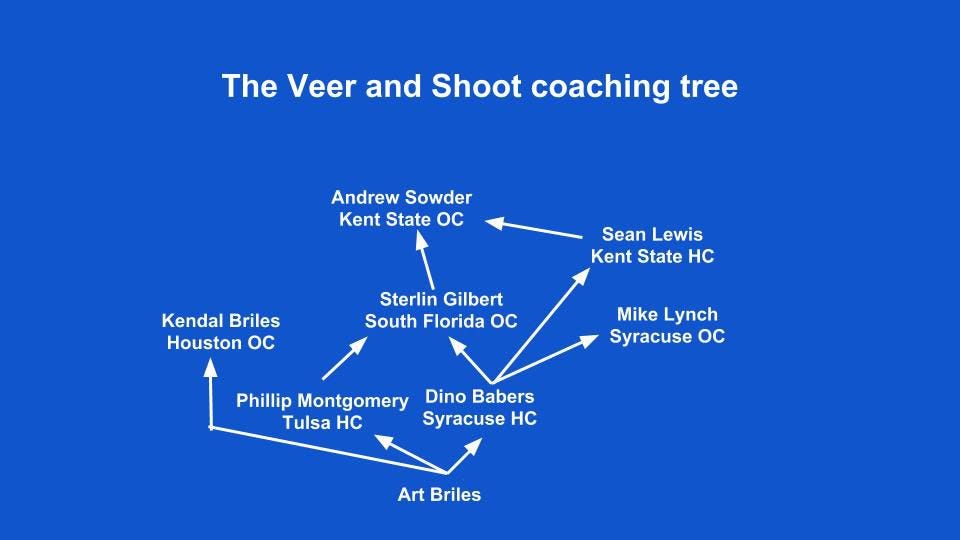




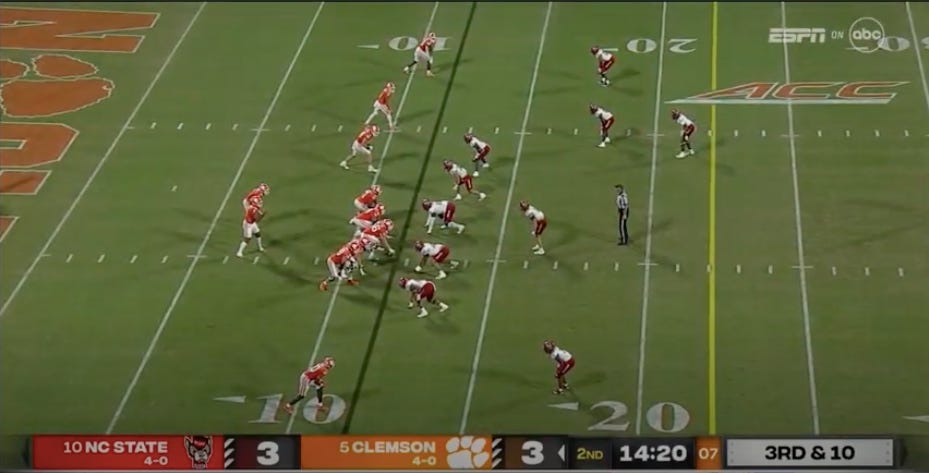


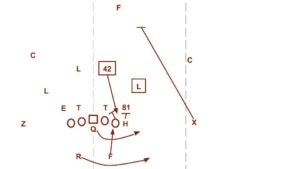
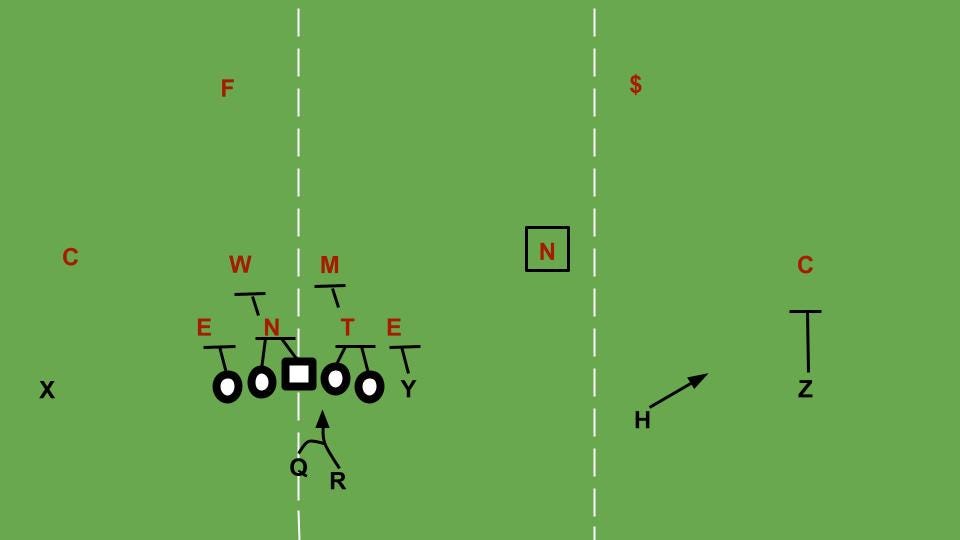
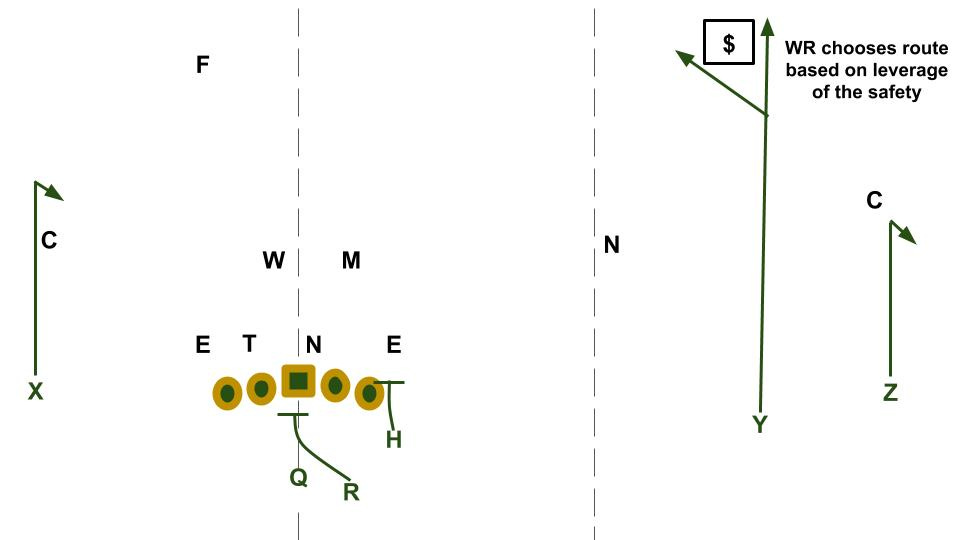
I think it was 2013 you wrote on Baylor in SBnation? 2013 is when I discovered CFB and opened up the Xs and Os in ways I understood. https://deadspin.com/why-baylor-is-porn-for-football-nerds-1468141463 "Baylor is Porn for Football Nerds" - And I was becoming one.
I had already learned the Run Game, had already been reading Smartfootball.com (RIP) ; but Baylor's scheme and how they made the math work for them, splitting all the way to the sidelines, made me understand spread and spread to run offenses like Chip Kelly and Urban Meyer and Gus Malzahn's Auburn. 2013 was an exciting season I watched in winter 2014. Spread to run offenses reigned. And Ironically, Pro Style Florida State won it all but t least it was a thrilling contest vs Auburn.
from what I understand, Baylor would tag run plays with 'win' routes. I can't remember where I read that, perhaps Flyover football (the book), but basically you'd have inside zone/power/counter X win or something like that. X receiver goes deep on a choice route while the boundary side/opposite side receivers would just kinda walk.. saving energy. The read was the run and X receiver, there was no backside/frontside option half the time. Cool stuff. I was such a huge fan of the Briles offense, shame the dude had to be so incredibly scummy.